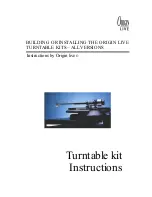
11
Custom Plinths
If you are designing your own custom plinth (and sub-chassis if included) – arrange it such that the sub-platter and
motor pulley will be level. You will also need to consider adequate depth for the bearing house and suspension if used -
See previous diagram on “cross-section of suspended sub-chassis”. The dimensions of the plinth layout diagrams are
suited to accept the lid option, however if you dispense with the lid you can go for something free of shape constraints.
An example of such a design is shown below. The advantage of such a design is that it cuts out excess material and thus
stores less energy. Suggested materials are MDF, veneered chipboard, acrylic (i.e. perspex), PVC, Marble, Granite or
Hardwood surround. It should be noted that the plinth is nowhere near as critical as the sub-chassis design.
Diagram of free form plinth example
Foot
Note:- the above outline can also be used as a one piece non sub chassis design
Sub chassis shape (plate)
Can be above or below plinth
Plinth shape
Non lid example
Suggested plinth cross-section for suspended subchassis design
Suggested height dimensions of Ultra kit
Plinth top plate
18mm
Plinth surround
80mm
Foot usually nailed into plinth (or if possible screwed)
The holes and geometry of the arm mounting holes on arms other than the Rega are best worked out using the arm itself
or manufacturers instructions (The first plinth layout diagram shows the critical dimensions for Linn and Rega
mounting). Ensure beforehand that the depth of holes etc will accept the arm in question.
The preceeding diagrams show plinth layout dimensions for guidance.
If you have ordered the Origin Live sub-chassis and wish to make your own plinth then you can use the sub-chassis
itself as a template to mark the positions for the spring support rod holes (which are 5mm dia).
Sub-chassis design
If it is desired to use a sub-chassis there are various options listed for suspension or de-coupling as follows.
Springs
Spikes
Rubber bands
Cantilever strut












































